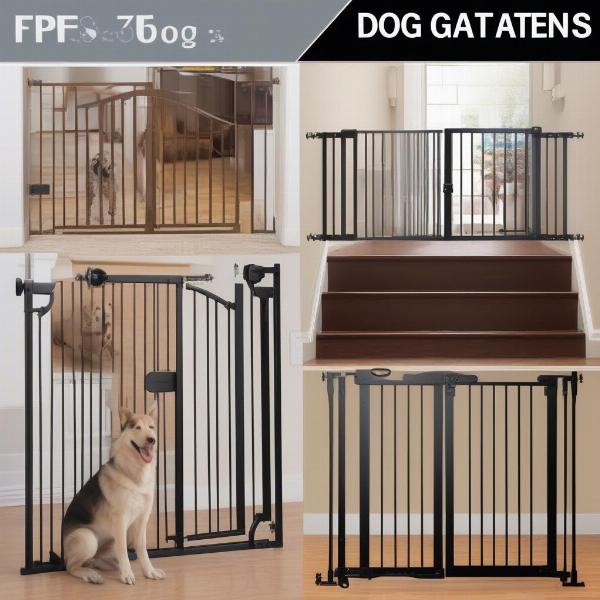A dog gate for stairs is a vital piece of equipment for many dog owners, providing a simple yet effective way to manage your dog’s access within your home. Whether you have a rambunctious puppy, a senior dog with mobility issues, or simply want to create designated safe zones, a well-chosen stair gate can offer peace of mind and prevent accidents. This article will guide you through the essential aspects of selecting, installing, and using dog gates for stairs.
Choosing the Right Dog Gate for Your Needs
Selecting the right dog gate depends on a few key factors: your dog’s size and temperament, the width of your staircase, and the style of your home. For small dogs, a basic pressure-mounted gate might suffice, while larger or more determined breeds may require a more robust, hardware-mounted option.
Considering Your Dog’s Size and Temperament
A small, docile dog might be perfectly content behind a shorter gate, while a larger, more energetic breed may require a taller, sturdier barrier. Consider your dog’s jumping ability and tendency to chew or paw at things. For persistent escape artists, a gate with closely spaced bars or a solid panel design might be necessary.
 Dog gates for stairs in various sizes and styles
Dog gates for stairs in various sizes and styles
Measuring Your Staircase Accurately
Accurate measurements are crucial for a secure fit. Measure the width of the staircase opening at its narrowest point. Consider any trim or molding that might interfere with the gate’s installation. Some gates offer extensions for wider openings.
Matching Your Home’s Style
Dog gates come in various materials and finishes, from metal and wood to plastic and mesh. Choose a gate that complements your home’s decor and integrates seamlessly into your living space.
Installation and Safety Tips for Dog Gates
Proper installation is key to ensuring your dog gate’s effectiveness. Follow the manufacturer’s instructions carefully and ensure the gate is securely fastened, whether you’re using pressure mounts or hardware.
Pressure-Mounted Gates
Pressure-mounted gates are easy to install and remove, making them a popular choice. However, they are not as secure as hardware-mounted gates and may not be suitable for top-of-the-stairs installations due to the risk of the gate collapsing.
Hardware-Mounted Gates
Hardware-mounted gates offer maximum security and are ideal for top-of-the-stairs installations. They require drilling into walls or banisters, providing a more permanent solution.
General Safety Precautions
Regularly check the gate for any signs of damage or wear. Ensure the locking mechanism is functioning correctly and that there are no gaps or spaces your dog could squeeze through. Never leave a small child unattended with a dog, even with a gate in place.
Living with a Dog Gate for Stairs
A dog gate can greatly enhance safety and provide peace of mind. By strategically placing gates, you can prevent your dog from accessing potentially dangerous areas, like the stairs, while still allowing them to enjoy the rest of your home.
Creating Designated Safe Zones
Dog gates can be used to create designated safe zones for your dog, such as a quiet area for them to retreat to when feeling overwhelmed or a puppy-proofed space for playtime. This can be particularly helpful during house training or when introducing a new pet to the household.
Managing Multi-Pet Households
In multi-pet households, dog gates can help manage interactions between animals, especially if there are differences in size or temperament. They can provide a safe space for a smaller or more timid pet to escape from a more boisterous one.
Conclusion
A dog gate for stairs is a valuable investment for any dog owner prioritizing safety and peace of mind. By carefully considering your dog’s needs and the specifics of your home, you can choose a gate that provides a secure and effective barrier, preventing accidents and creating a more harmonious living environment for both you and your furry friend. Remember to always follow manufacturer instructions for installation and regularly check the gate’s integrity for optimal safety.
FAQ
- Are pressure-mounted gates safe for the top of the stairs? Generally, no. Pressure-mounted gates are not recommended for top-of-the-stairs installations due to the risk of the gate collapsing.
- What is the best type of gate for a large dog? For a large dog, a sturdy, hardware-mounted gate is often the best option, particularly if they are strong or prone to jumping.
- How tall should a dog gate be? The height of the gate should be at least a few inches taller than your dog’s shoulder height when standing on their hind legs.
- Can I use a baby gate for my dog? While some baby gates might work for small dogs, it’s generally recommended to use gates specifically designed for pets as they are typically stronger and more durable.
- How do I clean a dog gate? Most dog gates can be cleaned with a damp cloth and mild detergent.
- What if my dog tries to climb or jump over the gate? If your dog attempts to climb or jump the gate, consider a taller gate or a different style, such as one with a solid panel.
- Are there retractable dog gates for stairs? Yes, retractable dog gates are available, offering a space-saving solution.
Related Articles:
About ILM Dog
ILM Dog is your trusted international resource for expert dog care advice. We’re dedicated to providing practical and reliable information on dog breeds, health, training, nutrition, grooming, products, and more, catering to both new and experienced dog owners worldwide. Whether you’re seeking guidance on choosing the right breed or managing a health condition, ILM Dog is your go-to source for valuable insights and support. For personalized assistance, connect with us at [email protected] or call us at +44 20-3965-8624.